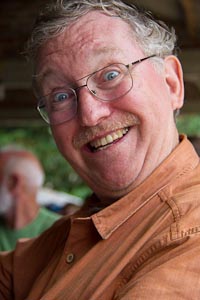 Sorry for the long delay between posts. Between nights with no electricity, nights with no internet, and simply nights with no personal energy, a week has gone by since the last mailing. I wrote dribs and drabs here and there, but am many days behind. Let’s see how far we can catch up tonight, though I can’t send it out till tomorrow at the earliest, since we are at a homestay up in the hills of North Vietnam, with one lone electrical plug that I have to scoot all the furniture to reach, and no internet. This is easiest my longest post to date, since it covers the longest period so far.
Sorry for the long delay between posts. Between nights with no electricity, nights with no internet, and simply nights with no personal energy, a week has gone by since the last mailing. I wrote dribs and drabs here and there, but am many days behind. Let’s see how far we can catch up tonight, though I can’t send it out till tomorrow at the earliest, since we are at a homestay up in the hills of North Vietnam, with one lone electrical plug that I have to scoot all the furniture to reach, and no internet. This is easiest my longest post to date, since it covers the longest period so far.
I thought the progression of guides thus far was an interesting review (for me) of where we have been so far:
1) Dave was our first guide in Cambodia. He is a Brit, so speaks flawless English. He is also an expert photographer that knows just where to go for the best photographic images, and gives good ongoing advice on composition and how to look at things.
2) Sorn was our local guide in Siem Reap, while Dave was the photography guide. Sorn was able to tell us how to get around floods to reach otherwise inaccessible areas, and helped interact with the locals. Most of my interaction during this time was with Dave, though it was clear that Dave often relied on Sorn for these aspects.
3) Warren isn’t an official guide, but he has come into our trip a couple times for drinks and dinner, and he is the one that arranged our Vietnam itinerary. Another Brit, with flawless English and an excellent knowledge of the region, plus a lifetime of fascinating vagabond stories.
4) Ta was our next guide. A native Cambodian, he spoke excellent English, and had innate photographic talent. He first took us to a typical tourist site, but when we explained that was not what we wanted, he shifted gears quickly and understood just what we wanted.
5) Once we crossed over into South Vietnam, we met up with Mai. A native Vietnamese, she has advanced degrees in both English and Russian. She was a joy to travel with over a period of 4 days. Again speaking flawless English, and quickly gaining an understanding of the types of images we were interested in making. The only “training” we had to do was to convince her to order less food. (see below)
So far, our guides have been nothing short of outstanding, with every one an expert and joy to be with.
Now, back to the beginning…
[Travel] Vietnam Day 6 – Off with his beard!
[Travel] Vietnam Day 6 – Let it Pour, Let it Pour, Let it Pour
[Travel] Vietnam Day 6 – We are Millionaires!
[Travel] Vietnam Day 6 – The High cost of Vietnam
[Travel] Vietnam Day 6 – Too Much Food!
[Travel] Vietnam Day 6 – The Mekong River is Disappearing!
So many titles. I couldn’t choose which to use, so am giving them all! 🙂
Monday, Oct 17:
 We are now in South Vietnam. (Yeah, I wrote that a week ago…) Our local guide, Mai, commented that I looked like Santa Claus with the white beard. OK, that was enough — off it came! Evelyn wanted me to keep the mustache. I am not convinced it looks good, but Mai commented the next morning that she likes guys with a little hair on their upper lip. With two women ganging up on me, what am I to do but follow orders? 🙂
We are now in South Vietnam. (Yeah, I wrote that a week ago…) Our local guide, Mai, commented that I looked like Santa Claus with the white beard. OK, that was enough — off it came! Evelyn wanted me to keep the mustache. I am not convinced it looks good, but Mai commented the next morning that she likes guys with a little hair on their upper lip. With two women ganging up on me, what am I to do but follow orders? 🙂
There is no flooding going on in the Southern region of Vietnam, where we are. Each afternoon, the skies start to darken though, and the wind starts to blow. Within minutes, rain starts. The locals rush under cover, or bring out their makeshift tarp covers while the sky opens and rain falls by the bucketload. Time to find a nice bar, order a fruit smoothie and watch the torrents unfold. Within half an hour, and sometimes less, the rain stops, the tarps are folded back, the windows unshuttered, we finish our tea or smoothie and continue our wandering. The air is fresh, the sidewalks are washed, and you realize what a good idea these daily quick thundershowers are.
In Cambodia, everyone wanted US Dollars. When we entered Vietnam, Mai (our local guide) told us that locals mostly wanted Vietnam Dongs and that we should convert some money. We went to the hotel desk and gave them a $100 bill, asking for change. Imagine our surprise when we were given a fat stack of bills totaling 2,000,000 Dongs. Turns out the exchange rate is 20,000 Dongs for $1, so that 100,000 Dong bill is really only $5. Oh well, at least we are millionaires in Dongs…
We were warned about the high cost of living in Vietnam, compared to Cambodia. Whew, were they ever right! Dinners that cost us $2 in Cambodia were now double the price. We had to pay up to 80,000 Dongs for a dinner now. Oh yeah, that is $4. Even a doubling of the price still makes it a bargain by any home standards.
A bigger problem is the Bigger Food though. Every meal results in almost as much food on the table for the 2 of us as Evelyn’s parents used to supply for a family of 14 — and I always said her parents supplied too much food back then. Invariably the host comes by and wonders why we didn’t like the food, when just one of the 6 or 7 dishes would have been more than enough for a complete meal for both of us. I fear we finally had to just stand firm and insult our hosts and tell our guide that we were not going to eat that much, and PLEASE do not order so much food. We have finally made progress on that front, since today’s meal (lunch in Saigon) was only twice as much as we could eat.
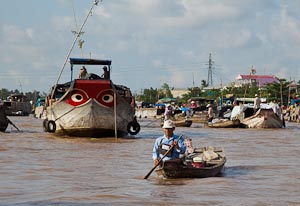 The population of Vietnam is exploding, and there simply is not enough land to support everyone. We have taken several private boat tours along the Mekong River over the past few days. A common element is to see homes along the banks building retaining walls out into the river. They build these walls, then dredge the river to provide landfill as they turn the banks of the river into more arable land. The new land is very fertile and is perfect for small farms and nurseries. There were places we saw where this had been done 2 or 3 times already, with another barrier in the process of being built further out. I fear that if this is not controlled, the Mekong will turn into a creek, probably with disastrous flooding consequences.
The population of Vietnam is exploding, and there simply is not enough land to support everyone. We have taken several private boat tours along the Mekong River over the past few days. A common element is to see homes along the banks building retaining walls out into the river. They build these walls, then dredge the river to provide landfill as they turn the banks of the river into more arable land. The new land is very fertile and is perfect for small farms and nurseries. There were places we saw where this had been done 2 or 3 times already, with another barrier in the process of being built further out. I fear that if this is not controlled, the Mekong will turn into a creek, probably with disastrous flooding consequences.
We went to an the Phung Hiep floating market in Can Tho. There were numerous semi-permanent large houseboats that made the core of the market. They tended to be roped together 2 or 3 or 4 wide. We were told those were the boats of an extended family, with a son’s family in one boat and daughter’s family in another.
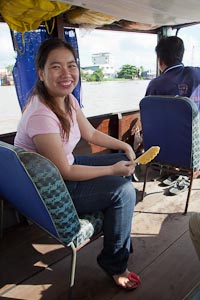 Many of the boats had a bamboo pole sticking up from the bow, with the item being sold tied to it. So we saw one pole with a potato, and sure enough, they were selling sacks of potatoes. Another had a watermelon on the stick, or pineapple (we had a pineapple-on-a-stick as
Many of the boats had a bamboo pole sticking up from the bow, with the item being sold tied to it. So we saw one pole with a potato, and sure enough, they were selling sacks of potatoes. Another had a watermelon on the stick, or pineapple (we had a pineapple-on-a-stick as
a snack) or cabbage, or… pretty much any food you could want. Smaller boats were zooming around as floating bars (selling drinks) or smaller amounts of odd foods. Other small boats were the customers, and they would buy supplies, then later go down the tributary channels and blow their horn to let the locals know their floating supermarket had arrived.
One surprising thing we saw back on land was that many woman wore full masks over their faces while riding their scooters. 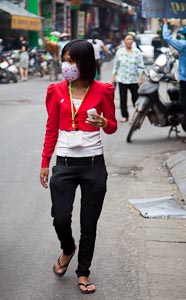 Mai pointed out that many of them also had full length sleeves and long pants to avoid sun exposure — all in an effort to maintain a fair skin. The Vietnamese standard of beauty is the fairest skin possible — very much like a Caucasian. Mai told us that her skin is no longer fair, and that she feels she is not as pretty as the other girls that have gotten skin-whitening or were born with fairer skin. I assured her that the natural olive complexion of SE Asians was considered highly desirable in America.
Mai pointed out that many of them also had full length sleeves and long pants to avoid sun exposure — all in an effort to maintain a fair skin. The Vietnamese standard of beauty is the fairest skin possible — very much like a Caucasian. Mai told us that her skin is no longer fair, and that she feels she is not as pretty as the other girls that have gotten skin-whitening or were born with fairer skin. I assured her that the natural olive complexion of SE Asians was considered highly desirable in America.
After the water market, we visited a market on land. Food was the primary commodity, with the same skinned frogs (though not hopping this time) we saw in Cambodia — this time on the tray right next to live frogs with their legs banded. 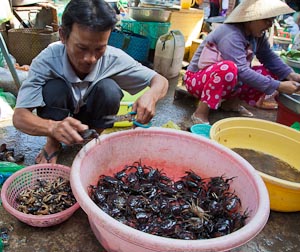 The customer could decide to take home the live frogs, or have a “prepared dinner” with the frogs already skinned.
The customer could decide to take home the live frogs, or have a “prepared dinner” with the frogs already skinned.
Other items were for sale there too though. One thing we bought was a thick stack of $100 US bills — for about 20 cents. They are a surprisingly good representation, though the paper was clearly wrong. If you looked close though, the back had the “In God We Trust” along with a Vietnamese phrase that translated to “The Bank of Hell.” Darn. Guess I won’t be passing those around home anytime soon… These are used by locals at funerals, where they burn (fake) money so the 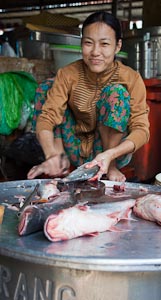 deceased will be able to buy stuff in the afterlife.
deceased will be able to buy stuff in the afterlife.
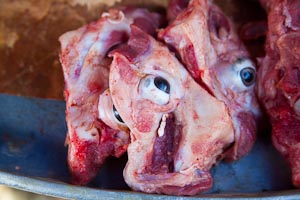 We had the afternoon to ourselves, and walked down to a recommended restaurant. After lunch, we decided to walk around town. Before we had gone a block, the wind whipped up and the sky opened, so we dashed under a near overhang.
We had the afternoon to ourselves, and walked down to a recommended restaurant. After lunch, we decided to walk around town. Before we had gone a block, the wind whipped up and the sky opened, so we dashed under a near overhang.
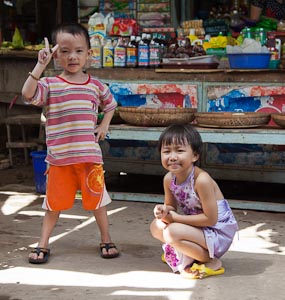 After standing under that overhang for a few minutes, we decided to retreat to the lunch restaurant. Dashing the block through the torrents, we returned to our seats and ordered a fresh round of fruit smoothies, and watched the show unfold. About then the waiters started dropping tarps over the edge of all the open areas to shield the tables from the storm. We stopped them from closing us in, so we could watch the storm rage.
After standing under that overhang for a few minutes, we decided to retreat to the lunch restaurant. Dashing the block through the torrents, we returned to our seats and ordered a fresh round of fruit smoothies, and watched the show unfold. About then the waiters started dropping tarps over the edge of all the open areas to shield the tables from the storm. We stopped them from closing us in, so we could watch the storm rage.
As expected, about 30 minutes later the rain suddenly stopped — you could literally see it recede down the street as the rain moved on to clean other areas. The waiters rolled the tarps back up, the world went on its now cleaner way, and we sauntered off to buy our last Vietnam purchases — some belts and a new wallet. (We aren’t much into souvenir hunting these days)
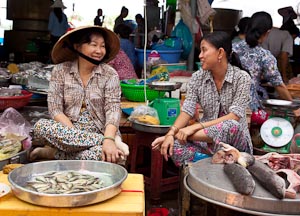 We continued to be amazed by just how friendly everyone is. Even the occasional person that signaled “no photo” was smiling and polite when turning away, and they were the exception. Most people would laugh and allow us to photograph. We would then show them their picture on the back of the LCD, and they would laugh some more and call over their nearest friends. The others would then be even more cooperative in letting us shoot their photos.
We continued to be amazed by just how friendly everyone is. Even the occasional person that signaled “no photo” was smiling and polite when turning away, and they were the exception. Most people would laugh and allow us to photograph. We would then show them their picture on the back of the LCD, and they would laugh some more and call over their nearest friends. The others would then be even more cooperative in letting us shoot their photos.
Tuesday, Oct 18:
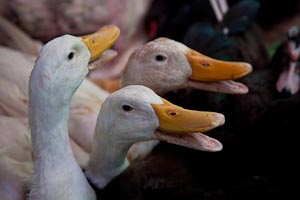 Tuesday found us traveling along the Mekong River again. First stop was a brick factory. I had rather expected to be bored there, since I had seen brick factories in other countries. This one was fascinating though. The scale was much larger than others we had seen around SE Asia, with 100,000 of a mold being made in a single batch, and the surplus 5,000 or so (these places always make extra in case of spoilage) being stored in a huge warehouse that was fun to wander through. We also walked into a huge empty kiln, and the size was impressive. Seeing another kiln in the cooling process, with the huge mountains of bricks with several hundred per layer, and at least 100 layers deep for a single batch really made you realize the size of the operation.
Tuesday found us traveling along the Mekong River again. First stop was a brick factory. I had rather expected to be bored there, since I had seen brick factories in other countries. This one was fascinating though. The scale was much larger than others we had seen around SE Asia, with 100,000 of a mold being made in a single batch, and the surplus 5,000 or so (these places always make extra in case of spoilage) being stored in a huge warehouse that was fun to wander through. We also walked into a huge empty kiln, and the size was impressive. Seeing another kiln in the cooling process, with the huge mountains of bricks with several hundred per layer, and at least 100 layers deep for a single batch really made you realize the size of the operation.
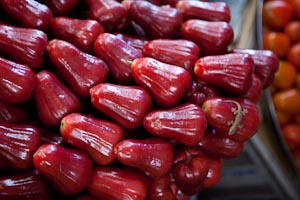 After a brief stay at the Tam Ho bonsai nursery (with bonsai trees reaching 10 feet tall?) for lunch, we headed to our first homestay.
After a brief stay at the Tam Ho bonsai nursery (with bonsai trees reaching 10 feet tall?) for lunch, we headed to our first homestay.
Turns out that “homestay” in Vietnam is what we would call a Bed & Breakfast in America. We had expected more the “stay in the village elder’s home” as we did in the hill tribes of Thailand 10+ years ago. This was downright civilized in comparison. Mai said it was “pretty basic”, but we were pleasantly surprised to discover we had a private room with electricity, a private shower/toilet, and even running hot water. Wow — that is “luxury basic” compared to what we were expecting.
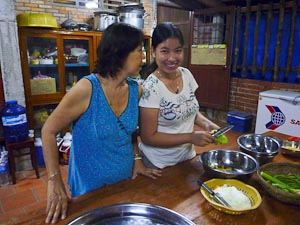 While there, we were invited to help prepare dinner. We shredded the vegetables, I sliced the crinkled potatoes that would become french fries (though the chef overcooked them for our taste). I then learned how to make spring rolls. I must brag and say that the spring rolls I made that night were the best such rolls either of us has ever eaten! (Seriously, they were quite good, and I’m sure it must have been my wrapping that made the difference…)
While there, we were invited to help prepare dinner. We shredded the vegetables, I sliced the crinkled potatoes that would become french fries (though the chef overcooked them for our taste). I then learned how to make spring rolls. I must brag and say that the spring rolls I made that night were the best such rolls either of us has ever eaten! (Seriously, they were quite good, and I’m sure it must have been my wrapping that made the difference…)
As we were eating dinner, boats continued powering down the river, with a major accompaniment of racket. Mai said they were heading home after a day of working with tourists or doing their market sales. She didn’t say they would end soon, but we both thought it was implied.
NOT! All night long, at least once an hour, a HUGE boat would come powering right into our room. Or at least that is what it sounded like. The racket was amazing! In the morning, Mai told us that boats that were running overloaded would often run at night when the police did not patrol the river, so they could carry more than was legally allowed. Sure enough, while eating breakfast, one late runner came by with the water up to the gunnel, at ris
k of swamping if another boat came past the other way and created too large a wake.
Wednesday, Oct 19:
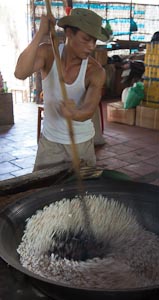 Wednesday we continued down the Mekong, and stopped at another interesting factory — this time making pop-rice. I had never heard of it before. We have popcorn at home, of course, but this was pop-rice. Sure enough, they heated a huge wok (maybe 4 feet across) with some oil in the bottom. When it was hot, they tossed in some rice, and started stirring. Within seconds, you heard the familiar pop-pop-pop, and could reach in and pull out some pop-rice as they continued until the popping slowed down — again, just like with popcorn. They then put it in other woks to combine with various flavorings, another wok to add something or other (I missed the name) that glued the rice together, then cut it into blocks. From there it was wrapped and sold, looking much like the rice cake we see in America, though not quite tasting the same.
Wednesday we continued down the Mekong, and stopped at another interesting factory — this time making pop-rice. I had never heard of it before. We have popcorn at home, of course, but this was pop-rice. Sure enough, they heated a huge wok (maybe 4 feet across) with some oil in the bottom. When it was hot, they tossed in some rice, and started stirring. Within seconds, you heard the familiar pop-pop-pop, and could reach in and pull out some pop-rice as they continued until the popping slowed down — again, just like with popcorn. They then put it in other woks to combine with various flavorings, another wok to add something or other (I missed the name) that glued the rice together, then cut it into blocks. From there it was wrapped and sold, looking much like the rice cake we see in America, though not quite tasting the same.
This factory also made snake wine (aka rice wine) — with a twist. Their cheap bottles just had the wine, but the (slightly) more expensive bottles had a real cobra in them, with the head expanded in the strike position. The bottles have tiny top holes, like you would see in a water bottle, so how the heck did they get the cobra in there?
They first fill the bottle with some water. Catch a live cobra and get it to crawl onto a stick that has one end in the bottle. The cobra will crawl down the stick and right into the bottle(!). It then gets worried about the water and rights itself with head up, so the head is out of the water. Next they put a mouse in front of the bottle, which causes the cobra to expand its neck into the familiar striking pose, as it prepares to eat. At that point, they put a cork in the bottle, and the cobra suffocates. Once it is dead, they drain the water, and put in the rice wine. They sometimes then insert a freshly killed scorpion and place it with tweezers into the the cobra’s mouth, to finish the tableau.
I bought a bottle to take to work when I get home… 🙂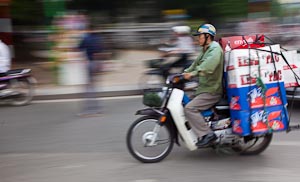
That day we also visited another floating market (Can Bo), though this one was smaller and we didn’t spend much time, a bee farm that made honey, and a coconut candy factory. Then it was onto a flight to Hanoi in the North.